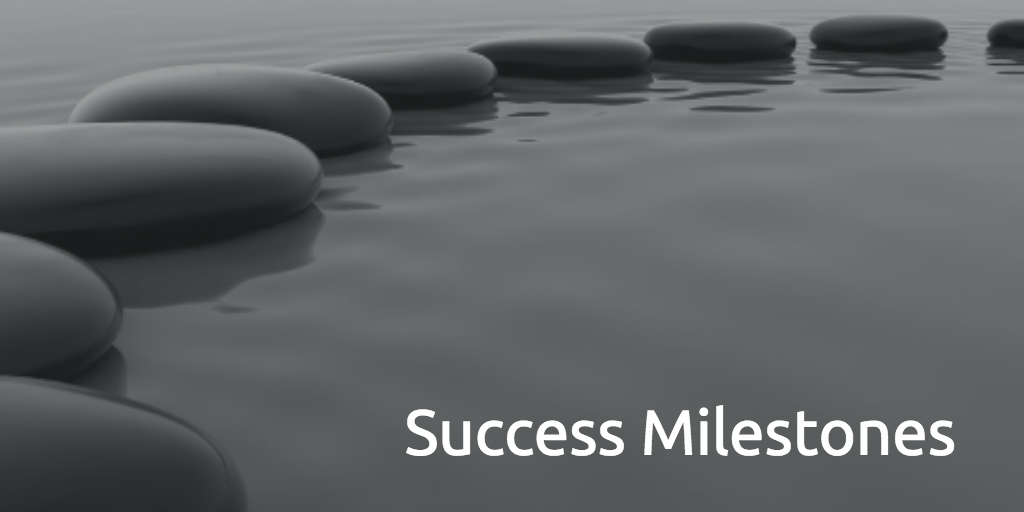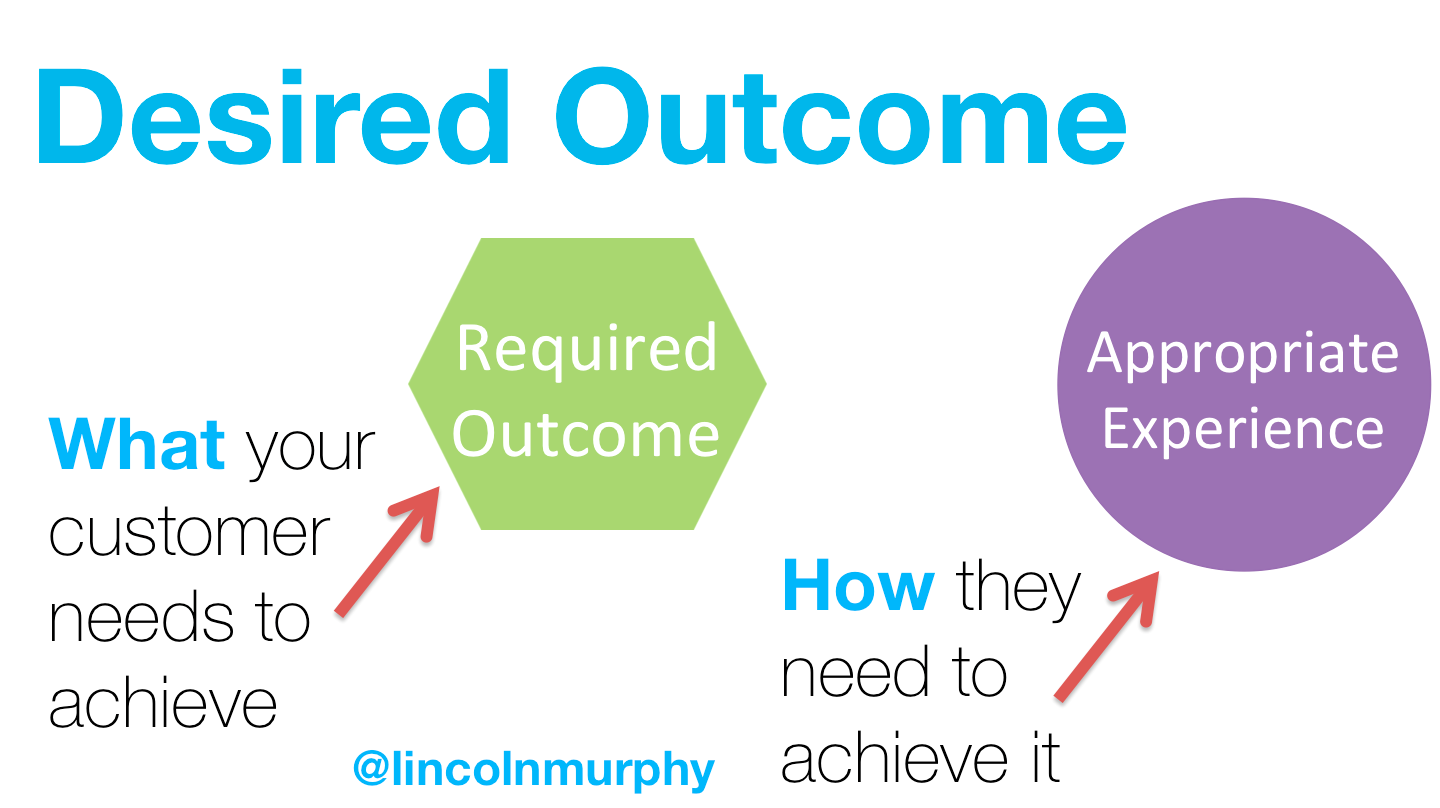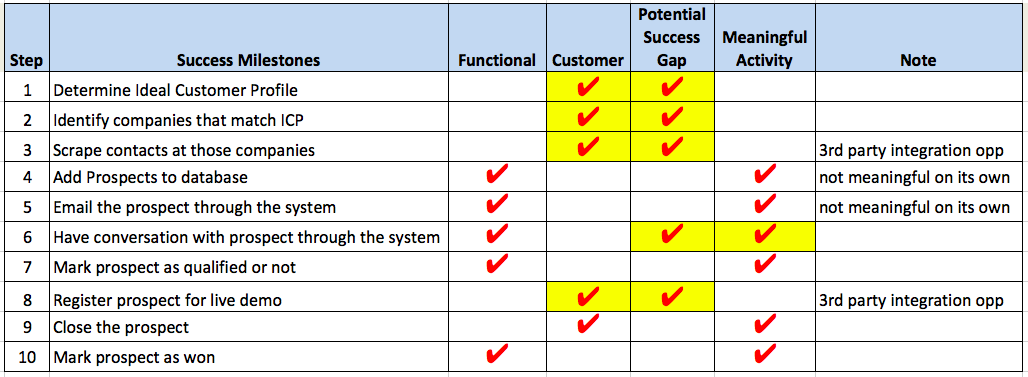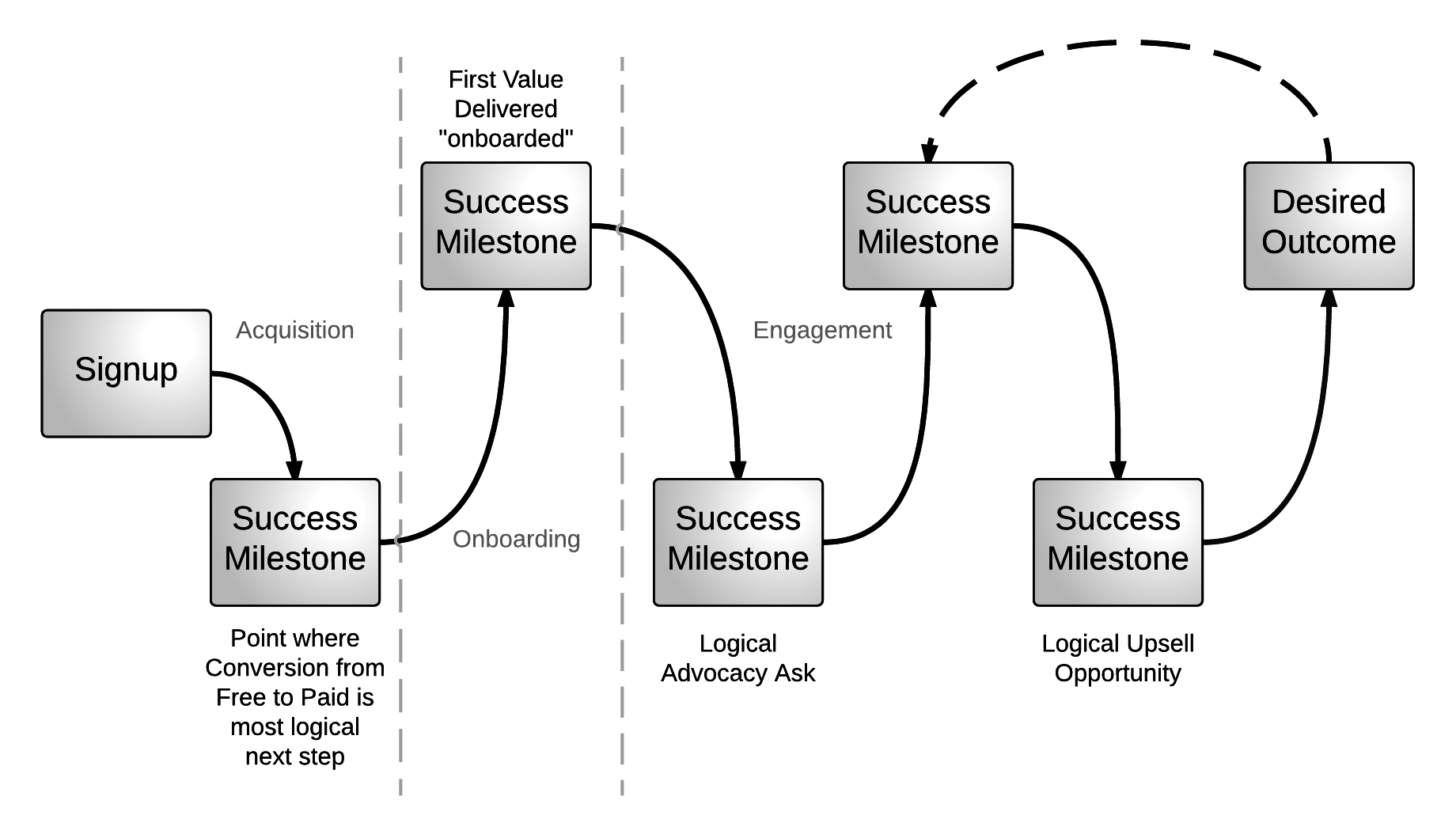 I talk about Success Milestones all the time, not just in the context of Customer Success, but in the context of the overall success of my SaaS clients and the companies I work with.
I talk about Success Milestones all the time, not just in the context of Customer Success, but in the context of the overall success of my SaaS clients and the companies I work with.
The concept of Success Milestones is a relatively simple one to grasp, but the power and the value of this way of thinking are often overlooked or misunderstood. Let’s fix that.
Since I’ve never really defined Success Milestones, what better time to do that than right now.
Everyone Gets Success Milestones Wrong
When I ask the companies I work with to come up with a list of success milestones for their customers, I usually get something like this:
Trial ==> Sale ==> Onboarding ==> Use ==> Upsell ==> Renewal
Those are phases of the customer lifecycle and – if they should even be considered milestones – they’re YOUR milestones as the vendor… they’re based around your success.
I tweeted this recently:
When I say "Desired Outcome" I'm 100% of the time talking about your customer's desired outcome… not yours. Yours is easy to figure out.
— Lincoln Murphy (@lincolnmurphy) October 7, 2015
So just to be clear… I’m talking about the Success Milestones of the customer, in the context of your product and their interactions with you.
So how does this differ from “customer journey maps” and the like? Let’s explore…
A Paper Map vs. Waze
Almost every customer journey map I see is vendor-focused and static.
The “customer experience” is almost always based around the product as the center of the universe, making it less a “customer” experience and more a “product” experience that the customer has.
The problem with that is – from the customer’s perspective – it’s always a “Customer Experience” … and when you opt to not focus on the customer and their Desired Outcome, you’ll instantly be misaligned with them, meaning whatever experience you orchestrate will be incongruent with the Appropriate Experience they’re looking for.
If that ends up working well for you, just know it’s in spite of your efforts rather than because of your efforts; only the latter efficiently scales.
Most customer journey maps or overall “Customer Experience” is based on an internally-focused goal; often but around our functionality, feature set, and ultimately our goals… rather than the goals of your customer.
You should have a clear starting point and a clear destination for your customer. Any map or navigation system requires at least those two inputs to be useful.
And when you sense the customer is veering off course, you recalculate and navigate them back on course. Unless they update the destination – which can happen along the way – you need to keep guiding them back toward their Desired Outcome.
And if they do change the destination mid-trip, that’s fine… help them arrive at the new destination.
I’m not sure how organizations that claim to be focused on Customer Success or “Customer-centric” can do that without baselining customers when they sign-up and clearly understanding the customers’ evolving Desired Outcome across their lifecycle as a customer, but that’s a discussion for another day.
No matter the metaphor, ultimately,…
Desired Outcome is the Goal
 Success Milestones are the steps required for a customer to achieve their ever-evolving Desired Outcome.
Success Milestones are the steps required for a customer to achieve their ever-evolving Desired Outcome.
Remember, Desired Outcome has two parts: Required Outcome and Appropriate Experience.
Required Outcome is the customer’s goal, the thing your customer is trying to accomplish; it’s what gets you in the game. If you can’t help them achieve this, that’s a total non-starter.
Appropriate Experience (or what I refer to as AX) is how your customers want or need to achieve that Required Outcome. This is why they bought your product and didn’t just use Excel or roll their own. It’s why they chose you over a commercial competitor. it’s why they chose you over a different-but-functionally-equivalent product.
It’s called “appropriate” instead of “great” or some other adjective because, well, we’re talking about an experience that is appropriate for the customer.
If the customer needs a “great” or “polished” or “high-end” or “bare-bones” experience, then that is what’s appropriate for them. Know your customer.
So once you know what their Desired Outcome is (point B) – and you know where they are today (point A)- you can more easily come up with the steps to get them from Point A to Point B.
But this requires getting clear on two very important things: the difference between functional and success milestones.
Defined: Success Milestones
Success Milestones are an action or event marking a significant change or stage in the customer’s journey toward their ever-evolving Desired Outcome.
Between Milestones there are steps.
Success Milestones can be product- or customer-centric, and it’s critical to know the difference and where they both fit in.
Functional Milestones
The easiest way to think about functional milestones is to label this “product-centric” or milestones that are reached / occur inside the product.
Almost every technology company focuses here. Period.
Unless you’re pegging the functional milestones to the success-oriented use of your product, it’s easy to mistake “functional use” for meaningful activity.
Focusing solely on Functional Milestones also exposes the customer to Success Gaps which are caused by the Desired Outcome of the customer being outside the scope of complete functional use of the product.
So, in addition to Functional Milestones, you need to also pay close attention to…
Customer Milestones
Think of Success Milestones as “customer-centric” or milestones reached by the customer that may or may not take place within your product, but have a direct impact on their relationship with you.
Customer Success Milestones will include functional milestones within the product, of course, but they won’t just be activity for activity’s sake. They will be the result of meaningful activity and will be tied to other inputs to ensure we know that the customer is actually achieving their desired outcome.
It is critical that you understand what has to happen for the customer to be successful – for them to achieve their Desired Outcome – both within your product and outside of it and then operationalize around that.
Orchestrate as much of the process as you can and hold your customers accountable for the parts that are within the scope of their responsibility.
I covered some examples of early-stage Success Milestones before, but here’s an example we’ll pick up after onboarding is complete when the customer is an engaged user.
Email-based CRM
Desired Outcome is to close customers without having to talk to them on the phone

This is just an example I made up, but hopefully it gives you some ideas on how to go through the process for your customers.
The key takeaway is that if the customer continues to achieve those 10 milestones (probably more rapidly repeating steps 5-7, with 8-10 repeating less often but hopefully fairly often), they’ll continue to be a customer.
3 Reasons Customer Success Milestones are Valuable
If it’s not entirely clear why you should go to the trouble of mapping out the Success Milestones for your customers, let me give you three very quantifiable reasons to do so:

1. Conversion Rate Optimization
There will be a point in the Free Trial when becoming a paying customer is the most logical next step. That’s a big success milestone itself, sure, but there were probably some things they needed to do before then to get to that point. Those are also success milestones, too, and at certain points in the customer lifecycle you’ll need to get fairly granular.
2. Expansion Opportunities
This is my all-time favorite use of Success Milestones and is really the key to the efficient scaling of your existing customer base by orchestrating Upsell and Cross-Sell activity. Some Success Milestones (not all of them; don’t force it) have a logical expansion opportunity associated with them.
It’s at that point that an add-on makes the most sense, buying additional seats because it’s time to invite Project Managers into the mix, or spinning up a relationship with an adjacent department or division is the logical next step.
The sales mantra of “right message, right time” is powered by Success Milestones.
3. Customer Advocacy
I spoke too soon earlier… this is my favorite use of Success Milestones. Fine… I love them all!
Look, when asking your customer to be an advocate for you – either internally and externally – doing so after they’ve achieved a Success Milestone is the perfect time to ask.
There are definitely going to be other data-driven times to reach out with an advocacy ask, after a strong NPS survey response, for instance, but there are going to be milestone-based times to make that ask, too. Know what those are and operationalize that process. In fact, start early with small asks and increase the level of ask over time, again, pegged to their success.
Your list of Success Milestones will vary… but if you apply this type of thinking to your business, your success won’t. Or it might.
No guarantees. But thinking this way probably won’t hurt.



